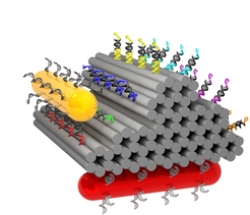Sep 26 2015
Nanotechnology is taking its first steps. Researchers from the Max Planck Institute for Intelligent Systems in Stuttgart have developed a gold nanocylinder equipped with discrete DNA strands as ‘feet’ that can walk across a DNA origami platform. They are able to trace the movements of the nanowalker, which is smaller than the optical resolution limit, by exciting plasmons in the gold nanocylinder.
Plasmons are collective oscillations of numerous electrons. The excitation changes the ray of light, thus allowing the researchers to actually observe the nanowalker. Their main objective is to use such mobile plasmonic nanoobjects to study how miniscule particles interact with light.
 A gold cylinder with DNA feet can climb over DNA-primed hills made from folded DNA strands. The second cylinder (red) serves as a point of reference for observing the nanowalker.
A gold cylinder with DNA feet can climb over DNA-primed hills made from folded DNA strands. The second cylinder (red) serves as a point of reference for observing the nanowalker.
Nanomachines – i.e. mechanical devices with dimensions of nanometers – could one day carry out specific tasks in fields such as medicine, information processing, chemistry or scientific research, according to nanotechnology experts. Yet miniature machines that are thousands of times smaller than the diameter of a human hair pose significant challenges for scientists: firstly, the individual constituents merely consist of a small number of atoms; it is barely possible to handle such components, let alone assemble them in a precise manner. Moreover, the machines would then need to be supplied with energy. And ultimately, the researchers cannot simply check to see if their device is in fact working. The microscopy techniques necessary for such observation are complex and require for example vacuum chambers, in which the devices would be destroyed. At the Max Planck Institute for Intelligent Systems in Stuttgart, a team of researchers including Chao Zhou and Xiaoyang Duan, headed by Laura Na Liu has now created a nanowalker that they can observe with the help of a nanooptical effect.
The body of the nanowalker consists of a gold cylinder that is 35 nanometres long and ten nanometres wide. “The cylinder’s surface is primed with numerous identical strands of DNA that effectively serve as feet,” Group Leader Liu explains. These DNA strands stick out from the gold cylinder like the bristles of a bottle brush. “They allow the gold cylinder to make contact with the surface underneath and travel across it.”
The nanowalker strides across a carpet of DNA strands
The gold cylinder’s walkway is composed of DNA as well – a DNA origami template, to be precise. Extended from this folded DNA scaffold like fibres from a carpet are longitudinal rows of short strands that are parallel to the cylinder and serve as footholds for the walker’s tiny feet. Each row in the DNA carpet comprises a different combination of bases, and each row represents one station. Initially, the walker’s feet bind with two neighbouring rows, while the footholds of the other rows remain blocked.
“The walker moves forward in a rolling motion, from station to station,” says Liu. In order to make this possible, the researchers must constantly add short snippets of DNA to the fluid in which the action is taking place. These snippets are designed to match the DNA of the individual rows. First they break up a row of connections linking the walker’s feet and the DNA of the platform and block the footholds of that particular station. On the opposite side of the walker, they then unblock a separate row, to which the cylinder’s feet can now attach.
“Depending on what is added, the walker moves either in one direction or in the other,” explains Liu. “We are inspired by naturally occurring molecular motors: The fluid moves the cylinder and its feet back and forth by means of thermal motion.” Due to the fact that the feet only ever redock on one side, the walker slowly moves forward. Each step is seven nanometres long, which is over one hundred thousand times smaller than the single stride of a wood ant.
Researchers use plasmon resonance to trace the nanocylinder’s path
In order to trace the tiny machine’s path, the researchers relied on a nanooptical effect called plasmon resonance. Plasmons are collective oscillations of numerous electrons and are often present in metals, among other materials. “Light can interact with the plasmons in the gold,” Liu explains. “Light is partially absorbed in the process in our case, resulting in what is known as plasmon resonance.” By analysing the light beam, the researchers can measure this phenomenon.
Determining the cylinder’s exact location, however, required placing a second, stationary gold nanocylinder on the underside of the DNA origami platform. Broadly speaking, this second cylinder serves as a point of reference. The reason for this is because together, the two cylinders bring about a change in the circular polarisation of the light beam: Light consists of an oscillating electromagnetic field. The polarisation is equivalent to the direction in which the field oscillates; in circularly polarised light, it turns either clockwise or counterclockwise. By observing the spectral changes resulting from the interaction with circular polarized light, the researchers can determine the walker’s current position.
“By using this approach we were able to trace every single step. That’s why the walker is more than just a mobile element – it also provides information about its location,” says Liu. Sophisticated microscope technology thus became redundant for observing the plasmonic walker, which Liu deems a precursor of a “new generation of nanomachines with customised optical properties”. The researcher now aims to use this tool to further study the interaction of light and matter on a nanoscale, as well as the mechanical behaviour of nanoparticles. Because if the gold walker is indeed destined to one day reach its goal and complete various tasks, it still needs to take quite a few strides – and not just on DNA origami.